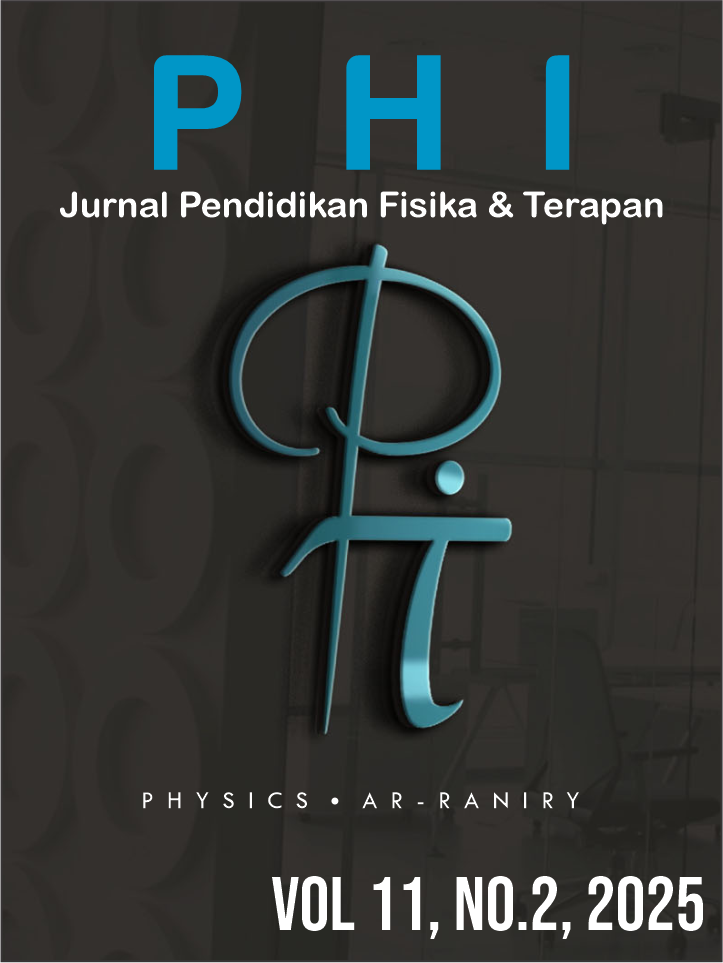Correlation Between the Quality of Free Body Diagram and Students' Understanding of Physics Concepts about Newton's Laws
DOI:
https://doi.org/10.22373/74n4jk30Keywords:
Free body diagram, Physics concepts, Newton’s LawsAbstract
This study aims to analyze the relationship between the quality of Free Body Diagram created by students and their understanding of Newton's Laws. This research employs a quantitative correlational method using a written test instrument and includes 40 eighth-grade students MTsS Lama Inong, Southwest Aceh Regency, using the purposive sampling technique. Data analysis was conducted using descriptive statistics, normality tests, linearity tests, Pearson correlation analysis, and significance tests. The results show that the average quality score of students' Free Body Diagram is 70.62, while the average conceptual understanding of physics is 60.87. The Pearson correlation test yielded a value of 0.900, with a t-value of 12.694, which is greater than the critical t-value of 2.024. The determination value of 0.804 indicates that the quality of Free Body Diagram contributes 80.4% to students' conceptual understanding. These findings demonstrate a very strong and significant relationship between the quality of Free Body Diagram created by students and their understanding of Newton's Laws. Therefore, the use of Free Body Diagram can serve as an effective instructional tool for enhancing students' conceptual. The implications of this study emphasize the importance of integrating visualization strategies in physics education to improve students' conceptual comprehension.References
‘Iffa, U., Supriana, E., & Sutopo, S. (2019). Kesalahan Siswa Dalam Mengidentifikasikan dan Menggambarkan Diagram Gaya. Jurnal Pendidikan: Teori, Penelitian, Dan Pengembangan, 4(7), 844. https://doi.org/10.17977/jptpp.v4i7.12612
Agnesa, O. S., & Sari, F. (2024). Pengembangan Modul Praktikum IPA Berbasis Keterampilan Proses Sains pada Program Studi PGMI. Jurnal Basicedu, 8(1), 643–650. https://doi.org/10.31004/basicedu.v8i1.7074
Ahmad, M. S., Rahayu, Y. S., & Sukarmin, S. (2023). Training Scientific Literacy Skills Through Inquiry Learning with Chemcollective’s Virtual Laboratory on Chemical Equilibrium. JPPS (Jurnal Penelitian Pendidikan Sains), 12(2), 155–175. https://doi.org/10.26740/jpps.v12n2.p155-175
Aini, S. and F. . (2020). Efektivitas Pembelajaran dengan Diagram Benda Bebas pada Hukum Newton secara Terintegrasi untuk Meningkatkan Penguasaan Konsep Siswa. JRPF (Jurnal Riset Pendidikan Fisika), 5(1), 12–17.
Anisya, N., Sutarsana, S., Widyawati, T., Hidayat, T., & Mahmudah, I. R. (2024). Analisis Penggunaan Free Body Diagram ( FBD ) Pada Materi Hukum Newton. Frekuensi, 1.
Ansumarwaty, F., & Doyan, A. (2023). Analysis of the Feasibility and Effectiveness of Ethnoscience-Based Science Learning Tools for Improving Students’ Science Literacy: A Review. AMPLITUDO : Journal of Science and Technology Inovation, 2(2), 119–124. https://doi.org/10.56566/amplitudo.v2i2.98
Arbaun, M., Makahinda, T., & Lolowang, J. (2021). Pengembangan Media Pembelajaran Interaktif Menggunakan Lectora Pada Materi Hukum Newtion Tentang Gerak. Charm Sains: Jurnal Pendidikan Fisika, 2(1), 49–52. https://doi.org/10.53682/charmsains.v2i1.79
Loliyana, N., Sukamto, G. M., & Andayani, E. S. (2019). Pengaruh Model Outdoor Learning terhadap Pemahaman Sejarah Mahasiswa Pendidikan Sejarah. Jurnal Pendidikan: Teori, Penelitian, Dan Pengembangan, 4(6), 803. https://doi.org/10.17977/jptpp.v4i6.12536
Mardini, A., Djamas, D., & Putra, A. (2018). Dampak Penerapan Free Body Diagram Terhadap Kemampuan Peserta Didik Menyelesaikan Soal-Soal Hukum Newton Dalam Pembelajaran Fisika SMA. Pillar of Physics Education, 11(2), 65–72.
Maulidina, S., & Bhakti, Y. B. (2020). Pengaruh Media Pembelajaran Online Dalam Pemahaman Dan Minat Belajar Siswa Pada Konsep Pelajaran Fisika. ORBITA: Jurnal Kajian, Inovasi Dan Aplikasi Pendidikan Fisika, 6(2), 248. https://doi.org/10.31764/orbita.v6i2.2592
Nurhayani, Mansyur, J., & Darsikin. (2015). Kualitas Diagram Benda Bebas Buatan Siswa Dalam Physics Problem Solving. Jurnal Sains Dan Teknologi Tadulako, 4, 28–35.
Permana, I., & Wayong, M. (2022). PENGEMBANGAN MODUL PRAKTIKUM FISIKA DASAR 1 TERINTEGRASI AYAT AL- QUR ’ AN Development of Practicum Module of Basic Physics 1 Integrated Version of the Qur ’ an. 2(1), 79–86. https://doi.org/10.24252/al-khazini.v2i1.31489
Pranata, O. D., & Lorita, E. (2023). Analisis Korelasi Kemampuan Berbahasa Panah Dengan Kualitas Free-Body Diagram Siswa Pada Materi Dinamika. Jurnal Pendidikan Fisika Dan Sains (JPFS), 6(1), 22–31. https://doi.org/10.52188/jpfs.v6i1.394
Puspitasari, R., Mufit, F., & Asrizal. (2021). Conditions of learning physics and students’ understanding of the concept of motion during the covid-19 pandemic. Journal of Physics: Conference Series, 1876(1). https://doi.org/10.1088/1742-6596/1876/1/012045
Robbany Arham, Hilman. Galih Adirakasiwi, A. (2022). Analisis Kemampuan Pemahaman Matematis Siswa Dalam Menyelesaikan Soal Matematika Dasar. Didactical Mathematics, 4(2), 314–322. https://doi.org/10.31949/dm.v4i2.2148
Rohmani, Sunarno, W., & Sukarmin. (2015). Pengembangan Media Pembelajaran Fisika Berbasis Multimedia Interaktif Terintegrasi Dengan LKS Pokok Bahasan Hukum Newton Tentang Gerak Kelas X SMA/MA. Jurnal Inkuiri, 4(1), 152–162.
Susilo, S. (2018). Pengaruh Pembelajaran Multirepresentasi Berbantuan Multimedia Terhadap Perubahan Jenis Representasi Siswa. Jurnal Penelitian Pendidikan IPA, 2(1), 11. https://doi.org/10.26740/jppipa.v2n1.p11-18
Tajriyaani, A., Lallo, J., Sinaga, P., & Utari, S. (2020). INVENTORY PEMAHAMAN GRAFIK DAN KEMAMPUAN REPRESENTASI KONSEP FISIKA SISWA SMP PADA POKOK BAHASAN KINEMATIKA. WaPFi (Wahana Pendidikan Fisika), 5(2), 1–5.
Utami, G., Suyanto, E., & Abdurrahman, A. (2013). The Influence of Free-body Diagram Representation Skill Towards the Concept Comprehension. Jurnal Pembelajaran Fisika Universitas Lampung, 1(1).
Wayan Oka Wisnu Wardana, Salamang Salmiah Sari, K. A. (2024). ANALISIS KEMAMPUAN REPRESENTASI FREE BODY DIAGRAM PADA MATERI HUKUM NEWTON. Jurnal Sains Dan Pendidikan Fisika (JSPF), 1, 35–45.
Y.H.M. Yusuf, K.A. Astiti, H.F. Lalus, & T. Haba. (2022). Analisis Kesulitan Siswa Dalam Menyelesaikan Soal-Soal Fisika Menggunakan Teori Polya Pada Materi Fluida Dinamik. Jurnal Pendidikan Dan Pembelajaran IPA Indonesia, 12(3), 140–146. https://doi.org/10.23887/jppii.v12i3.54706
Yanitama, A., & Listiaji, P. (2023). Jurnal Penelitian Pendidikan Development of the Practicum Guide e- module Basic Physics for Practice Student Science Process Skills. 40(1), 1–6.
Downloads
Published
Issue
Section
License
Copyright (c) 2025 Mahdil Marsyi

This work is licensed under a Creative Commons Attribution-NonCommercial 4.0 International License.
Authors who publish with Jurnal Phi agree to the following terms:
- Authors retain copyright and grant the journal right of first publication with the work simultaneously licensed under a Creative Commons Attribution License (CC BY 4.0) that allows others to share the work with an acknowledgment of the work's authorship and initial publication in this journal.
- Authors are able to enter into separate, additional contractual arrangements for the non-exclusive distribution of the journal's published version of the work (e.g., post it to an institutional repository or publish it in a book), with an acknowledgment of its initial publication in this journal.
- Authors are permitted and encouraged to post their work online (e.g., in institutional repositories or on their website) prior to and during the submission process, as it can lead to productive exchanges, as well as earlier and greater citation of published work (See The Effect of Open Access).

















